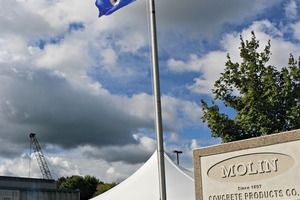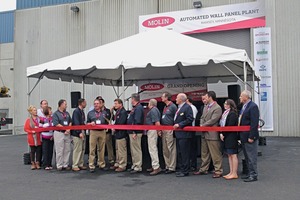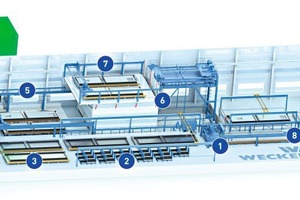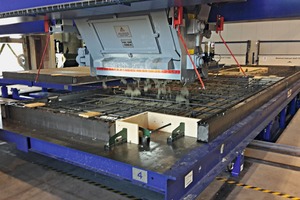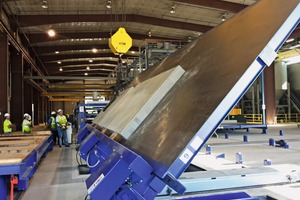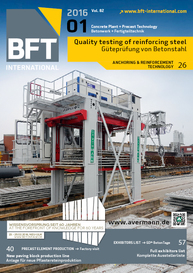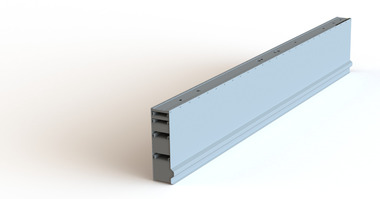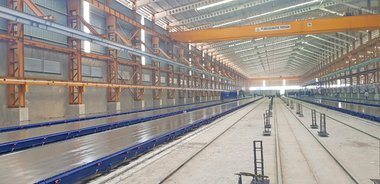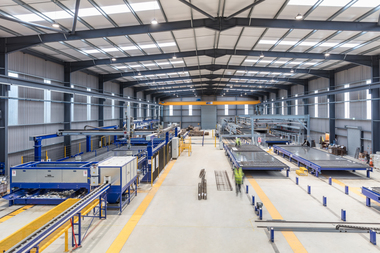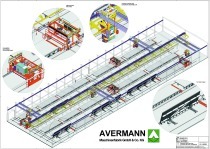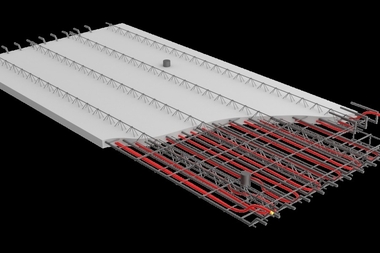One of the most modern precast plants in the USA formally opened
The company Molin Concrete Products has recently commissioned a precast plant for production of large-sized wall panels in Ramsey (Minnesota, USA). Established in 1897, the company, headquartered near Minneapolis, specialized after World War II in production of precast concrete elements. Today its portfolio includes prestressed concrete floor slabs, beams, columns, and solid-concrete wall panels for residential housing and industrial construction.
In 2011, considerations began to take shape to invest in an extension of its production capacity and to build a new plant for production of solid-concrete floor slabs, architectural façades, and insulated sandwich façades. Shortly afterward, a number of suppliers were contacted and representatives of the company accordingly traveled, also to Europe, to investigate marketing possibilities. In 2013, Molin after an evaluation process awarded the contract for design and installation of the facility to the German mechanical and plant engineering company Weckenmann. Delivery commenced in late 2014, and the plant was installed already during the first half of 2015. The first panels were manufactured in June of 2015. In addition to the design, installation, and commissioning of the complete plant, Weckenmann also trained the company’s personnel in the operation of the new plant.
Official opening celebrated in September of 2015
The highlight was the official opening of the plant on 24 September 2015. Several hundred customers, suppliers, representatives of the city and region, as well as business partners followed Molin’s invitation. The plant was presented under production conditions so that guests could obtain a first-hand impression of the precast plant and experience the making of large wall panels “live” during a guided tour of the plant.
The visitors, who at the end of the day exchanged impressions at a typical American buffet, were impressed by the new plant, as the manufacturer observed. The plant was put into operation by Molin at exactly the right time, as the US American precast concrete industry is experiencing a period of growth.
Precast element production on a circulation system
Production of precast elements on a circulation system is not yet widely practiced in the United States. They are commonly and conventionally manufactured on flat, stationary tables to which the concrete is delivered in buckets or transport vehicles. In circulating systems, the entire production process is computer-controlled and the pallets are carried from one processing station to the next. The Weckenmann WAvision control processor transfers all production data for controlling the processor to the master computer.
A production process begins with cleaning, plotting, and oiling of the pallet. The RPÖ station, as it called, is also fitted with a spray unit for applying retarding agents. The demolding process that follows takes place at the shuttering station by handling crane. After the pallet has left the formwork station, it travels across the reinforcing station to the casting area, which consists of two concrete spreaders, and from there on to the automatic compaction station.
From there, the concrete panels are transported to the curing chamber, where they are left to harden for 1 to 2 hours at around 49 °C. An automatic stacker crane then lifts the pallets on top of the chamber for screeding by a wing float before returning them to the chamber for final hardening. The next station in the circulating pallet system is the demolding station, which consists of a tilting table. Following demolding, the table is tilted to an angle of 70 ° and the precast elements are removed for transport to the construction site.
This not only reduces shop-floor space requirements, but staff costs as well. For the planned production capacity of 140,000 m² of wall panels, only 14 to 18 workers are now required, compared to the 48 previously needed for conventional production.
Overhead rail transport for heavy façade elements
A step soon to be implemented will be installation of a processing line for precast parts with architectural surfaces. Production of colored, exposed-aggregate, and sandblasted elements is planned. Weckenmann will deliver a curved overhead rail transport system for producing precast elements weighing up to 25 tons.
With the new plant, Molin now has one of the few automatic circulation systems in the United States and sets new standards in terms of production capacity and degree of automation. Molin was able to increase its productivity many fold and is therefore better able to satisfy the requirements of the market.

